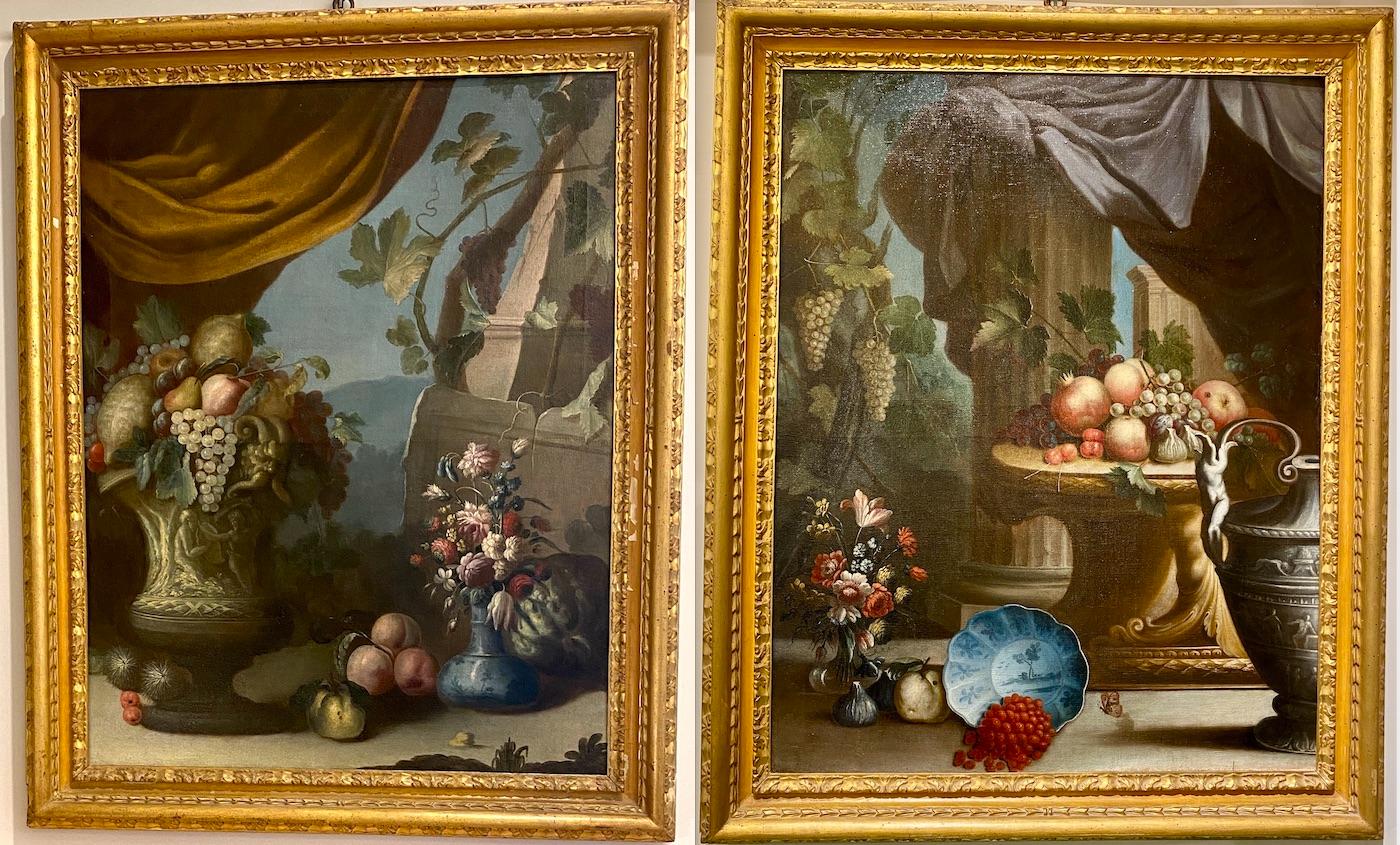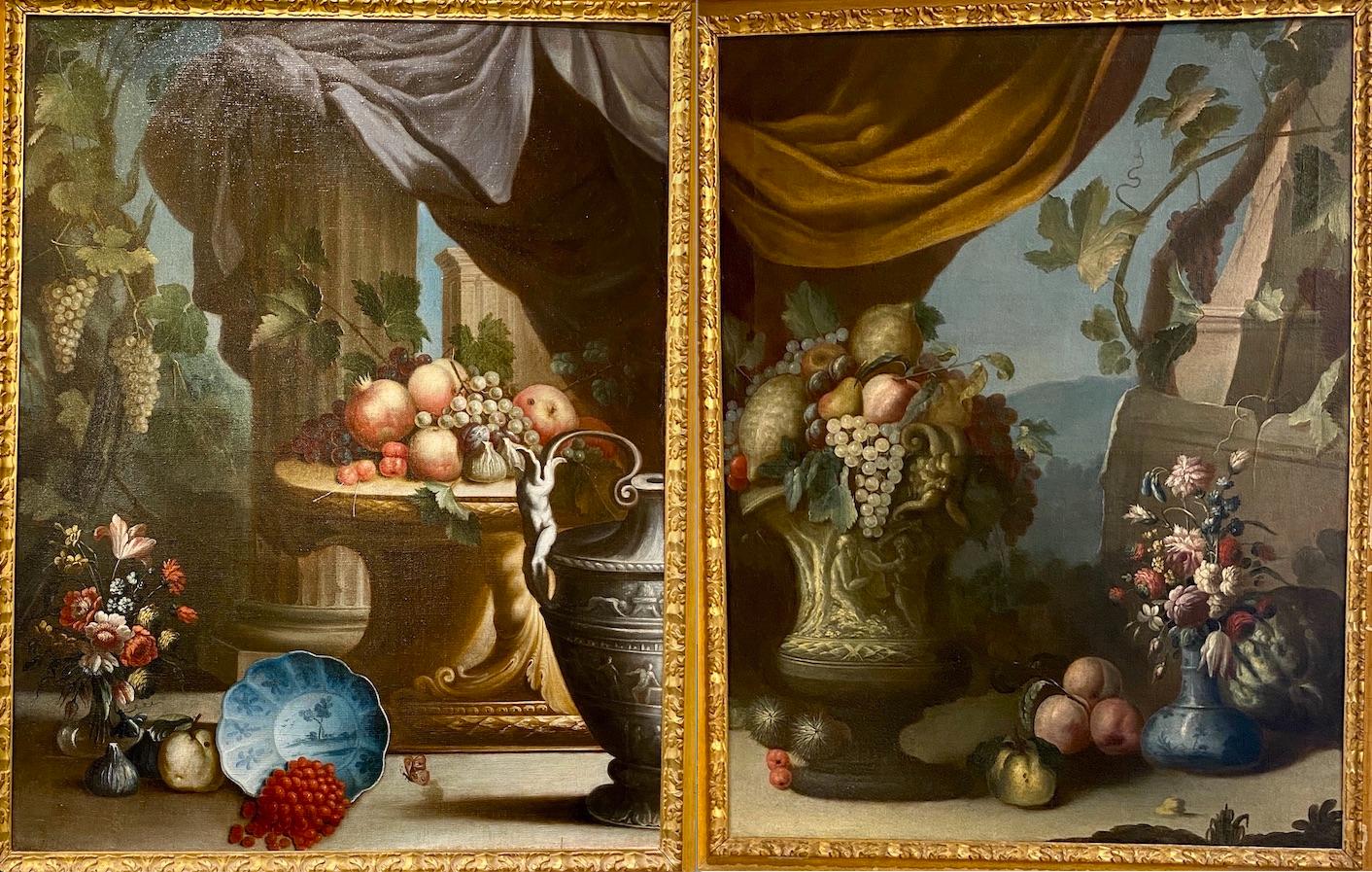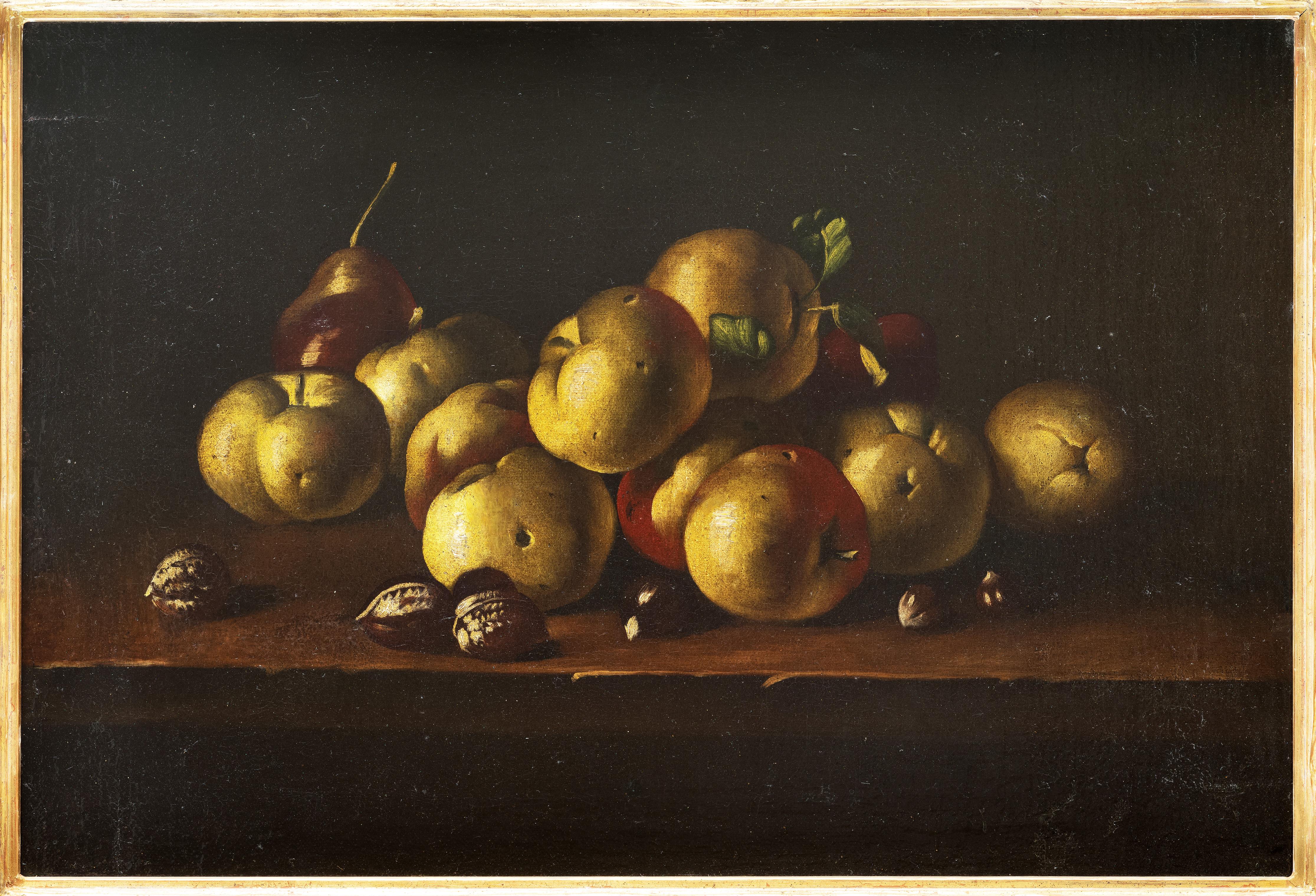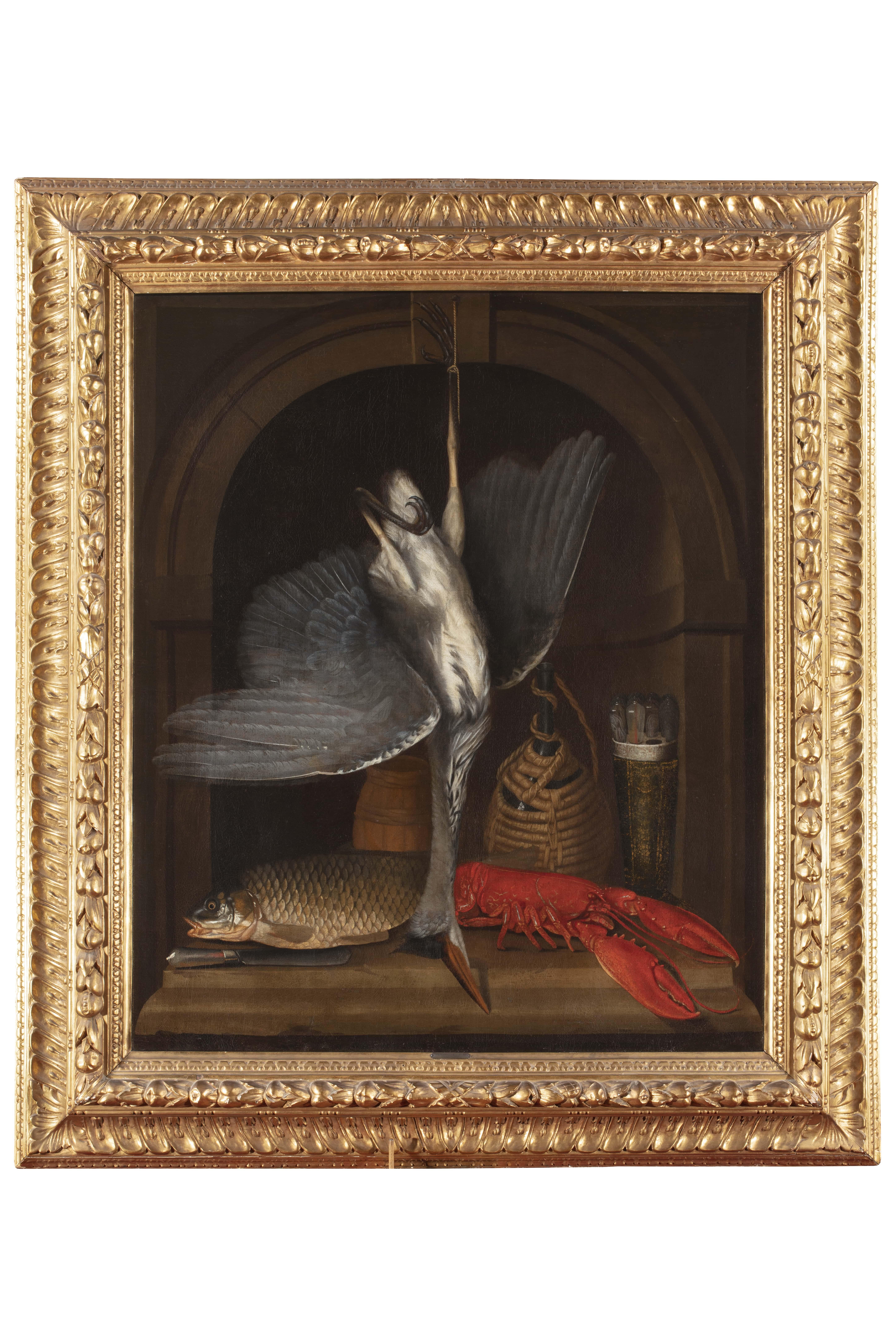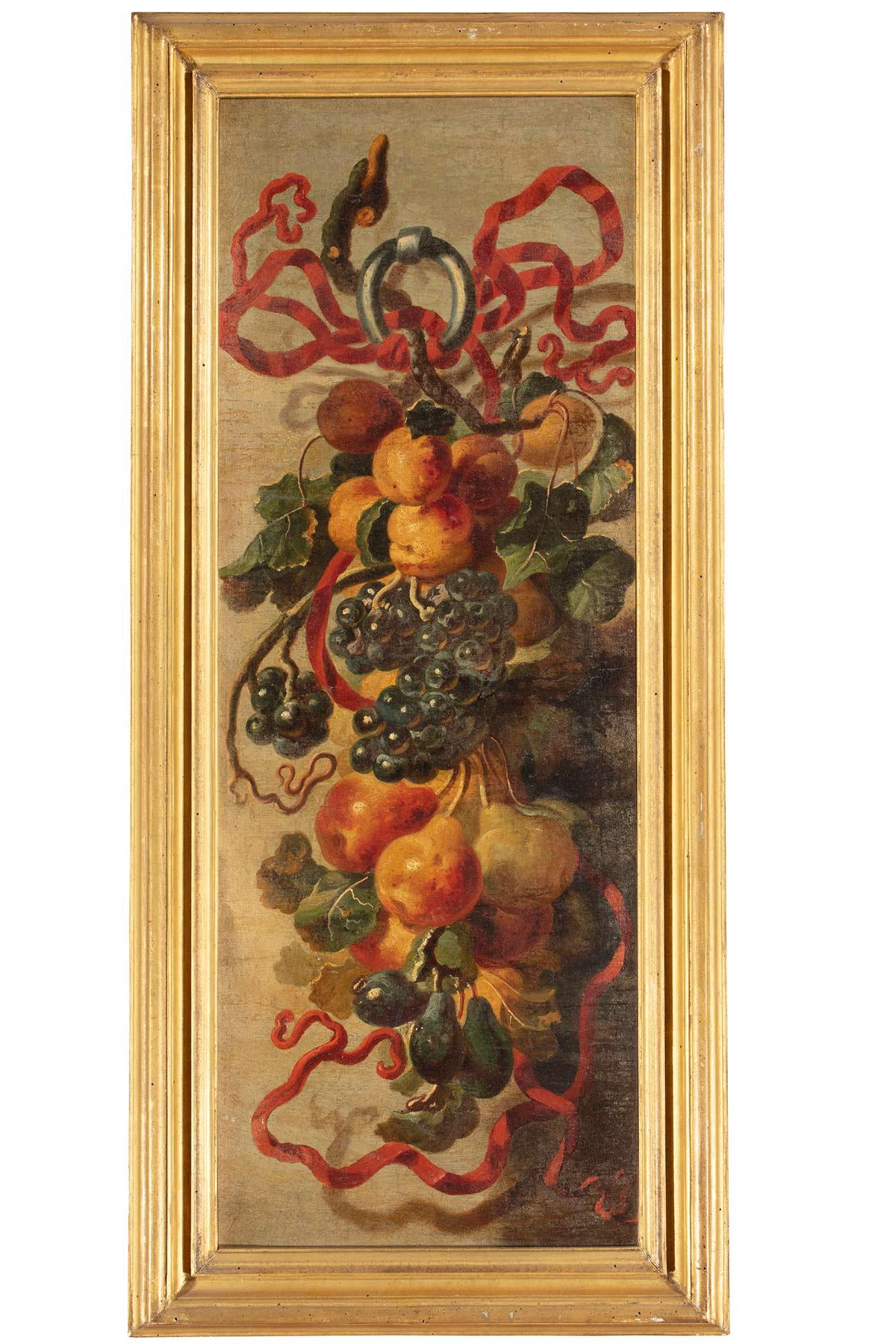Items Similar to French 18th century MONNOYER Flowers Oil canvas octogonal tulips decorative
Want more images or videos?
Request additional images or videos from the seller
1 of 10
French 18th century MONNOYER Flowers Oil canvas octogonal tulips decorative
About the Item
French school of the early 18th century Jean-Baptiste MONNOYER (Entourage de) Lille, 1636 – London, 1699 Oil on canvas laid down on panel 55 x 39 cm (67 x 53 cm with the frame) Very good condition (a few repaints)
This is an old canvas , close to Jean-Baptiste Monnoyer art. The good quality and the style indicates probably a date at the end of the 17th century or the beginning of the 18th century. The painting represents a bouquet of tulips, carnations, poppies of Christmas roses. It is an artificial composition and a very symbolic work. The red and white tulip is the symbol of passionate and pure love. The poppy flower is the symbol of dreams and rest. And the Christmas rose is both associated with Christmas and therefore with Incarnate Love. But the latter is also associated with black magic, its botanical name is "black hellebore" and it contains poison that burns. The poppy has been known since ancient times for its soporific, analgesic and narcotic effects. And the red carnation symbolizes pure and ardent love. So this painting has a meaning. It seems to symbolize love and its contradictions between purity, calm, rest, danger and passion ! An entablature and a decorative element on the right (a piece of column?) make this still life very theatrical. The octagonal shape of the painting makes the composition particularly decorative. This painting of flowers has a style close to Jean-Baptiste Monnoyer who created with his pupil Jean-Baptiste Blain de Fontenay the decorations of the castles of Louis XIV in the last quarter of the 17th century with Charles Le Brun. The very realistic way to paint botany reminds classical Flemish art of the 17th century. The colors are at both realistic and very beautiful. The tormented composition with flowers that seem to fall under their own weight is also characteristic of Monnoyer's art. As well as the color restricted palette with reds, whites and pinks with a hint of blue in cold overall tone.
- Dimensions:Height: 21.66 in (55 cm)Width: 15.36 in (39 cm)
- More Editions & Sizes:67 x 53 cm with framePrice: $2,404
- Medium:
- Movement & Style:
- Circle Of:Jean-Baptiste Monnoyer (1636 - 1699, French)
- Period:
- Condition:A few repaints and thinness.
- Gallery Location:PARIS, FR
- Reference Number:1stDibs: LU2524212249762
About the Seller
5.0
Vetted Seller
These experienced sellers undergo a comprehensive evaluation by our team of in-house experts.
Established in 2010
1stDibs seller since 2023
6 sales on 1stDibs
Typical response time: <1 hour
- ShippingRetrieving quote...Ships From: PARIS, France
- Return PolicyA return for this item may be initiated within 14 days of delivery.
More From This SellerView All
- Modern Salon painting Still life MASURE Flowers Japenese "Fleurs et japoneries"Located in PARIS, FRGeorges Paul MASURE (Active 1900s/1910s) Oil on canvas 80 x 65 cm (97 x 82cm with the frame) Signed and dated lower right "G. P. Masure / 1912" Painting exhibited at the Salon des Indépendants in 1913 (2032. « Fleurs et japoneries ») Beautiful 19th century frame Georges Paul Masure was a Parisian painter in the Montparnasse area. He exhibited at the Salon des Indépendants in the years 1900/1910. Our painting is the painting he exhibited at the Salon des Indépendants in 1913 under the number 2032 and titled "Flowers and Japaneries". It represents a still life with a bunch of flowers, a magnificent basket of oranges, a pomegranate and a Japanese sculpture with a little fisherman with a red Koi carp. 2500 years ago, when the son of Confucius was born, he received as a gift from King Shoko of Ro, a fish that was first called Koi. It represents the symbol of strength, because this fish was the only one able to go up the steam of the Yellow River. Owning a koi will long remain the prerogative of the Japanese nobility. The dominant colors in the painting are orange and red. And in Japanese Shinto...Category
1910s French School Still-life Paintings
MaterialsOil
- Painting Flemish school 17th century Oil canvas Still life fishes blueberriesLocated in PARIS, FRFlemish school of the 17th century Oil on canvas 52 x 60 cm (66 x 76 cm with the frame) Very beautiful old frame in gilded wood Good condition (a few repaints and craquelures) The style of our painting reminds the first period of Flemish still life of the 17th century, very descriptive and meticulous. We think of painters such as Osias Beert, Jacob van Es and Clara Peeters...Category
17th Century Still-life Paintings
MaterialsOil
- French romantic flowers Salon painter Mid 19th DUDAN Oil canvas beautiful frameLocated in PARIS, FRGabriel-Dominique DUDAN (Active 1830s-1850s) Oil on canvas 61 x 50 cm (77 x 66 cm with frame) Signed and dated lower right "G. Dudan / 1854" Beautiful carved and gilded wooden frame...Category
1850s French School Still-life Paintings
MaterialsOil
- BESSON Nature morte Fleurs Oranges Naturalism 19eLocated in PARIS, FRJules Gustave BESSON Paris, 1868 – Saigon, 1942 Oil on canvas 46 x 38 cm (53 x 44 cm with frame) Signed upper left “JBesson” An academic painter, Jules Besson studied with Cabanel a...Category
Late 19th Century Naturalistic Still-life Paintings
MaterialsOil
- French school modern art Still life oranges lemons 1914 Montparnasse frame 20thLocated in PARIS, FRFrench school from the beginning of the 20th century Oil on canvas 34 x 46 cm (53 x 63 cm with the frame) Signed and dated lower left "EB / 1914" Trace of signature lower right Very ...Category
1910s Modern Still-life Paintings
MaterialsOil
- Religious painting 17th 18th VIGNON Caravaggio follower Oil canvas Saint GregoryLocated in PARIS, FRClaude VIGNON (After) Tours, 1593 – Paris, 1670 Oil on canvas 60 x 45 cm (80 x 65 cm with the frame) Very good condition In the 17th century the french...Category
18th Century Old Masters Portrait Paintings
MaterialsOil
You May Also Like
- Still Life with Squash, Gourds, Stoneware, and a Basket with Fruit and CheeseLocated in New York, NYProvenance: Selma Herringman, New York, ca. 1955-2013; thence by descent to: Private Collection, New York, 2013-2020 This seventeenth century Spanish still-life of a laden table, known as a bodegón, stands out for its dramatic lighting and for the detailed description of each object. The artist’s confident use of chiaroscuro enables the sliced-open squash in the left foreground to appear as if emerging out of the darkness and projecting towards the viewer. The light source emanates from the upper left, illuminating the array, and its strength is made apparent by the reflections on the pitcher, pot, and the fruit in the basket. Visible brush strokes accentuate the vegetables’ rough surfaces and delicate interiors. Although the painter of this striking work remains unknown, it is a characteristic example of the pioneering Spanish still-lifes of the baroque period, which brought inanimate objects alive on canvas. In our painting, the knife and the large yellow squash boldly protrude off the table. Balancing objects on the edge of a table was a clever way for still-life painters to emphasize the three-dimensionality of the objects depicted, as well a way to lend a sense of drama to an otherwise static image. The knife here teeters on the edge, appearing as if it might fall off the table and out of the painting at any moment. The shape and consistency of the squash at left is brilliantly conveyed through the light brush strokes that define the vegetable’s fleshy and feathery interior. The smaller gourds—gathered together in a pile—are shrouded partly in darkness and stand out for their rugged, bumpy exterior. The stoneware has a brassy glaze, and the earthy tones of the vessels are carefully modulated by their interaction with the light and shadow that falls across them. The artist has cleverly arranged the still-life in a V-shaped composition, with a triangular slice of cheese standing upright, serving as its pinnacle. Independent still-lifes only became an important pictorial genre in the first years of the seventeenth century. In Italy, and particularly through the revolutionary works of Caravaggio, painted objects became carriers of meaning, and their depiction and arrangement the province of serious artistic scrutiny. Caravaggio famously asserted that it was equally difficult to paint a still-life as it was to paint figures, and the elevation of this new art form would have profound consequences to the present day. In Spain Juan Sanchez Cotan...Category
17th Century Old Masters Still-life Paintings
MaterialsCanvas, Oil
- Pair of Exceptional Italian 18th Century Still-Life PaintingsLocated in Rome, ITThis pair of excellent Italian still life oil on canvas with flowers and fruit with classical ruins on the background and colored drapes create harmony of the composition. Notable ...Category
Early 18th Century Old Masters Still-life Paintings
MaterialsOil
- Pair of Exceptional Italian 18th Century Still-Life PaintingsLocated in Rome, ITThis pair of excellent Italian still life oil on canvas with flowers and fruit with classical ruins on the background and colored drapes create harmony of the composition. Notable ...Category
Early 18th Century Old Masters Still-life Paintings
MaterialsOil
- Still Life with Apples and Nuts, 17th Century, Old Master, Spanish PaintingLocated in Greven, DEJuan Sánchez Cotán (1560 - 1627) was one of the most important still life painters in Spain and beyond. He developed a certain type of still life with a ...Category
17th Century Old Masters Still-life Paintings
MaterialsCanvas, Oil
- 17th century By Dutch maestro Still life with bird, carp & lobster Oil on canvasLocated in Milano, LombardiaThis painting fits well into the Dutch pictorial production of the Golden century. The composition, built on the harmonious presentation of rich wild game and fine details such as th...Category
17th Century Old Masters Still-life Paintings
MaterialsCanvas, Oil
- 17th Century by Giovanni Paolo Castelli Still Life Oil on CanvasBy Giovanni Paolo Castelli detto SpadinoLocated in Milano, LombardiaGiovanni Paolo Castelli called Spadino (Rome 1659 - Rome 1730) Still life Oil on canvas, cm. 81x31 - with frame cm. 92x41 Shaped and gilded wo...Category
Late 17th Century Old Masters Still-life Paintings
MaterialsCanvas, Cotton Canvas, Oil
Recently Viewed
View AllMore Ways To Browse
Pink Tapestry Salon Set
Sandy Murphy
Tyler Warren
Wild Boar Etching
Ann Getsinger
Bert Beirne On Sale
Dear Frances
Roo Waterhouse
Strawberry Rainbow
Thomas Morgan Inc
Barbara Castrucci On Sale
Bonsai Figurine
C F Goldie
Cartier Cubist Clock
Dark Wooden Desk
Emma Richardson Cherry
Flower 3 Bees Right Side
Gayle Wettingfeld

